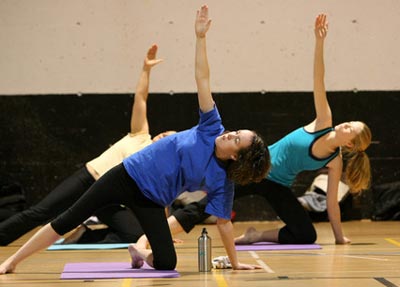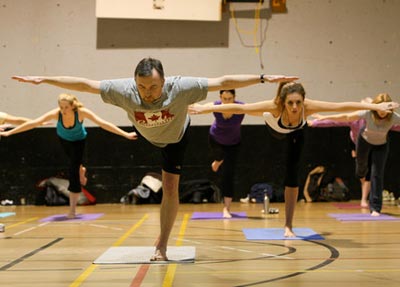 |
| The side plank works to strengthen arms and side abdominals. (Nick Pearce Photo) |
Before you launch into this story, relax and take a deep breath.
Seems simple enough, but in our fast-paced world more of us are forgetting to slow down and do this.
We spend more and more time being sedentary, trying to accomplish even more things in our days. But all of this activity and comes with a price. We are a population suffering from chronic stress.
Don’t despair—a growing number of people are discovering there is a way to reverse all of this stress and negativity: regular yoga practice.
Yoga is about more than just contorting your body into awkward positions and chanting “om” in a room full of strangers in an attempt to reach enlightenment.
“It really doesn’t matter what it looks like,” says Heather Reynolds, a certified yoga instructor and Dalplex’s climbing and outdoor recreation programming coordinator, “as long as the focus is on the breath.”
Everyday we are faced with stressful events in our daily routine—whether it’s sleeping through an alarm, traffic on the morning commute or difficult coursework. As a result of these daily events, our bodies react unconsciously by triggering our parasympathetic (fight-or-flight) response.
“Yoga attempts to counter the fight or flight response through breath work and poses. Once the body is trained to reduce stress in the moment, this can be carried over into everyday life,” says Ms. Reynolds.
 |
| This pose, Toppling Tree, helps improve balance. (Nick Pearce Photo) |
There is no denying that holding “dancer’s pose” or “tree” can be hard. Once you are able to hold a pose and breathe through it and then move on to the next, your body intuitively learns how to overcome difficult situations. The idea is, by being able to overcome minor stresses like a difficult pose, suddenly the bumper-to-bumper traffic or complicated text isn’t such a big deal anymore. All you need to do is remember to breath.
The amount of physical exertion involved in yoga is up to the individual. There are several different styles of yoga that are available both on campus through Dalplex and at private studios across the city. There truly is a style for everybody, regardless of physical fitness or age.
Dalplex offers a class specifically for students called Yoga - Live Well. The class is held later in the evening in order to accommodate students who have evening classes and continues through exam time. The current program is full but a second section of the class will be offered on Tuesdays and Thursdays, 9 to 10 p.m., starting February 1 at a space in O’Brien Hall.
Yoga is also offered as an Adult Fitness and Wellness program. Pre-registration is required. Yoga (Hatha/Kripala) is scheduled for Sundays, 3 to 4 p.m. at the Studley Dance Studio. Yoga (Vinyasa) goes Mondays and Wednesdays, noon to 1 p.m. in the Studley Dance Studio.
Yogaflex is also offered almost everyday on the Group Fitness Schedule. For these classes, no registration is required and there is no extra cost; Dalplex members can just drop in. Mondays, 9:30 a.m. to 10:30 a.m.; Tuesdays, 4:30 to 5:30 p.m.; Wednesdays, 5:30 to 6:30 p.m.; and Fridays, noon to 1 p.m.
Yoga glossary
Bikram/ Hot Yoga: Bikram Choudhury, known as the yoga teacher to the stars, developed this hot yoga practice in Los Angeles in the 1970s. The bikram class turns up the room temperature to anywhere from 85 degrees to 100 degrees. In this hot and steamy environment, students perform 26 poses designed to cleanse the body from the inside out. This is a vigorous workout. Restorative / Yin: A gentle practice with long poses that is therapeutic and deeply relaxing. Yin classes are ideal for those recovering from injuries or illness, as well as those who are looking to relax and unwind. Poses are held for an extended period of time and involved fewer poses than other practices. A meditative slow-paced class that explores long, deep stretching to enhance joint mobility and flexibility and by healing the body’s connective tissues. A good basic glossary of terms, postures and practices go to: http://www.danceceres.org/yoga/Yoga_Terminology.pdf |
